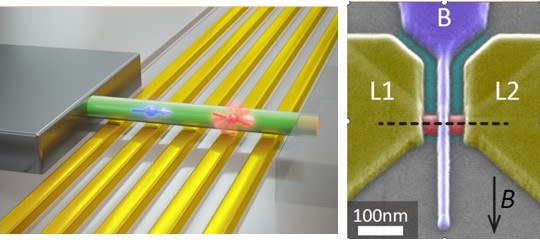PGI Kolloquium: Prof. Dr. Dominik Zumbühl, University of Basel, Basel, Switzerland
Dr. Peter Schüffelgen
Please note: You will receive the link to the online talk in the e-mail invitation, usually sent out a few days before the lecture takes place. It is also available on request from the contact person below.
Building small, fast and hot hole spin qubits in Si and Ge
Quantum computers hold the potential to solve key tasks exponentially faster than classical computers.Semiconductor spins are among the leading candidates for a highly scalable qubit platform. Hole spins in Ge/Si core/shell nanowires [1] offer exceptionally strong yet electrically tunable spin-orbit interaction (SOI) [2], the direct-Rashba SOI [3], allowing unprecedented control of key qubit parameters.
The Rabi frequency can be tuned with gate voltages, going from fast manipulation to idle modes, demonstrating a “spin-orbit switch”. Spin-flip times as short as ~1 ns are obtained, approaching the strong driving regime, with SOI length down to a few nm [4]. This qubit can also operate at temperatures of up to 2 K, and we are implementing an exchange based CROT 2Q gate and dispersive qubit readout approaching the single shot regime.
The silicon fin field-effect transistor (FinFET) is the leading geometry for classical transistor scaling, integrating billions of FinFETs on a chip. Here, we show that a Si FinFET can host a hole spin qubit and operate above 4 K, potentially allowing in-situ integration of the control electronics. We achieve all-electrical control and 1Q gate fidelities at the fault-tolerance threshold [5-7]. Further, we demonstrate a CROT gate with spin-orbit induced anisotropic exchange interaction, opening the door to high fidelity and fast 2Q gates, thus taking an important step towards quantum information processing.
This work was supported by the NCCR SPIN, the Swiss NSF, the Swiss Nanoscience Institute (SNI), the Georg H. Endress Foundation, and the EU H2020 European Microkelvin Platform EMP.


[1] Froning et al., Appl. Phys. Lett. 113, 073102 (2018), arXiv:1805.02532
[2] Froning, Rančić et al., Phys. Rev. Research 3, 013081 (2021), arXiv:2007.04308
[3] Kloeffel, Trif, and Loss, Phys. Rev. B84, 195314 (2011).
[4] Froning, Camenzind et al., Nature Nanotechnology 16, 308 (2021), arXiv:2006.11175
[5] Kuhlmann et al., Appl. Phys. Lett. 113, 122107 (2018), arXiv:1807.04121
[6] Geyer, Camenzind et el., Appl. Phys. Lett. 118, 104004 (Mar, 2021), arXiv:2007.15400
[7] Camenzind, Geyer et al., Nature Electronics 5, 178 (Mar, 2022), arXiv:2013.07369
Bio:
After a physics diploma from ETH Zürich and an MSc at Stanford University, Dominik received his PhD from Harvard University in 2004, working on coherence and spins in GaAs quantum dots. After a brief postdoc at MIT, Dominik started his own group in 2006 at the University of Basel where he has been working ever since.
In 2008, he received an ERC starting grant in the first ERC call. After being promoted to associate professor in 2012, he served as the Chair of the Department from 2015-2019. Since Feb 2021, he is the director of the NCCR SPIN, the Swiss National Program on Quantum Computing with Si and Ge spins.
Dominik's research interests are in quantum transport experiments in semiconductor nanostructures, focusing on quantum computation with spins, coherence, interactions, quantum condensed matter at ultralow temperatures and machine learning for quantum devices.
